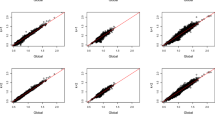Abstract
Highly multivariate disease mapping has recently been proposed as an enhancement of traditional multivariate studies, making it possible to perform the joint analysis of a large number of diseases. This line of research has an important potential since it integrates the information of many diseases into a single model yielding richer and more accurate risk maps. In this paper we show how some of the proposals already put forward in this area display some particular problems when applied to small regions of study. Specifically, the homoscedasticity of these proposals may produce evident misfits and distorted risk maps. In this paper we propose two new models to deal with the variance-adaptivity problem in multivariate disease mapping studies and give some theoretical insights on their interpretation.



Similar content being viewed by others
References
Barnard J, McCulloch R, Meng XL (2000) Modeling covariance matrices in terms of standard deviations and correlations, with applications to shrinkage. Stat Sin 10:1281–1311
Bernardinelli L, Clayton D, Montomoli C (1995) Bayesian estimates of disease maps: How important are priors? Stat Med 14:2411–2431
Besag J, York J, Mollié A (1991) Bayesian image restoration, with two applications in spatial statistics. Ann Inst Stat Math 43:1–21
Botella-Rocamora P, Martinez-Beneito MA, Banerjee S (2015) A unifying modeling framework for highly multivariate disease mapping. Stat Med 34(9):1548–1559
Congdon P (2008) A spatially adaptive conditional autoregressive prior for area health data. Stat Methodol 5:552–563
Gelman A, Carlin JB, Stern HS, Dunson D B, Vehtari A, Rubin D B (2014) Bayesian data analysis, 3rd edn. Chapman & Hall/CRC, Boca Raton
Gelman A, Hill J (2007) Data analysis using regression and multilevel/hierarchical models. Cambridge University Press, Cambridge
Gentle J E (2007) Matrix algebra. Theory, computations, and applications in statistics. Springer, Berlin
Lunn D, Thomas A, Best N, Spiegelhalter D (2000) WinBUGS-a Bayesian modelling framework: concepts, structure, and extensibility. Stat Comput 10:325–337
MacNab Y, Kemetic A, Gustafson P, Sheps S (2006) An innovative application of Bayesian disease mapping methods to patient safety research: a Canadian adverse medical event study. Stat Methods Med Res 25:3960–3980
MacNab YC (2016a) Linear models of coregionalization for multivariate lattice data: a general framework for coregionalized multivariate CAR models. Stat Med 35:3827–3850
MacNab YC (2016b) Linear models of coregionalization for multivariate lattice data: Order-dependent and order-free cMCARs. Stat Methods Med Res 25(4):1118–1144
MacNab YC (2018) Some recent work on multivariate Gaussian Markov random fields. TEST 27(3):497–541
Martinez-Beneito MA (2013) A general modelling framework for multivariate disease mapping. Biometrika 100(3):539–553
Martinez-Beneito MA, Botella-Rocamora P, Banerjee S (2017) Towards a multidimensional approach to Bayesian disease mapping. Bayesian Anal 12:239–259
Schrodle B, Held L (2011) A primer on disease mapping and ecological regression using INLA. Comput Stat 26:241–258
Scott JG, Berger JO (2010) Bayesian and empirical-Bayes multiplicity adjustment in the variable-selection problem. Ann Stat 38(5):2587–2619
Spiegelhalter DJ, Best NG, Carlin BP, Van Der Linde A (2002) Bayesian measures of model complexity and fit (with discussion). J R Stat Soc Ser B (Stat Methodol) 64:583–641
Acknowledgements
The authors acknowledge the support of the research Grant PI16/01004 (co-funded with FEDER grants) of Instituto de Salud Carlos III and predoctoral contract UGP-15-156 of FISABIO.
Author information
Authors and Affiliations
Corresponding author
Additional information
Publisher's Note
Springer Nature remains neutral with regard to jurisdictional claims in published maps and institutional affiliations.
Electronic supplementary material
Below is the link to the electronic supplementary material.
Rights and permissions
About this article
Cite this article
Corpas-Burgos, F., Botella-Rocamora, P. & Martinez-Beneito, M.A. On the convenience of heteroscedasticity in highly multivariate disease mapping. TEST 28, 1229–1250 (2019). https://doi.org/10.1007/s11749-019-00628-8
Received:
Accepted:
Published:
Issue Date:
DOI: https://doi.org/10.1007/s11749-019-00628-8
Keywords
- Gaussian Markov random fields
- Multivariate disease mapping
- Bayesian statistics
- Spatial statistics
- Mortality studies




